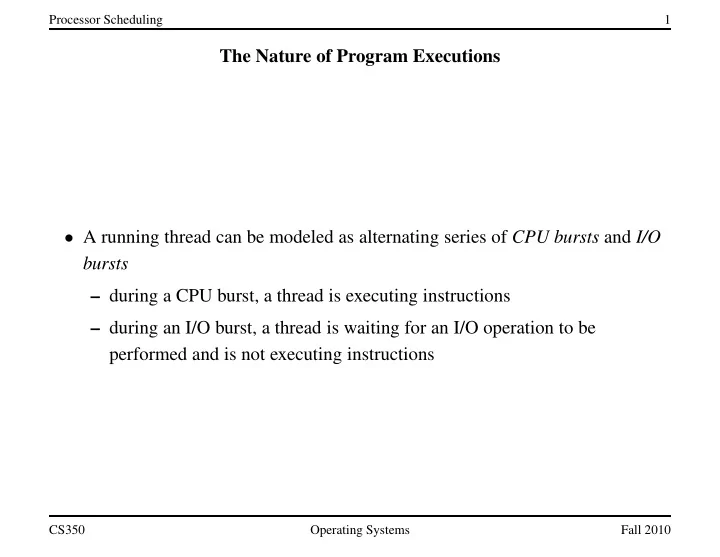

Processor Scheduling 1 The Nature of Program Executions • A running thread can be modeled as alternating series of CPU bursts and I/O bursts – during a CPU burst, a thread is executing instructions – during an I/O burst, a thread is waiting for an I/O operation to be performed and is not executing instructions CS350 Operating Systems Fall 2010
Processor Scheduling 2 Preemptive vs. Non-Preemptive • A non-preemptive scheduler runs only when the running thread gives up the processor through its own actions, e.g., – the thread terminates – the thread blocks because of an I/O or synchronization operation – the thread performs a Yield system call (if one is provided by the operating system) • A preemptive scheduler may, in addition, force a running thread to stop running – typically, a preemptive scheduler will be invoked periodically by a timer interrupt handler, as well as in the circumstances listed above – a running thread that is preempted is moved to the ready state CS350 Operating Systems Fall 2010
Processor Scheduling 3 FCFS and Round-Robin Scheduling First-Come, First-Served (FCFS): • non-preemptive - each thread runs until it blocks or terminates • FIFO ready queue Round-Robin: • preemptive version of FCFS • running thread is preempted after a fixed time quantum, if it has not already blocked • preempted thread goes to the end of the FIFO ready queue CS350 Operating Systems Fall 2010
Processor Scheduling 4 Shortest Job First (SJF) Scheduling • non-preemptive • ready threads are scheduled according to the length of their next CPU burst - thread with the shortest burst goes first • SJF minimizes average waiting time, but can lead to starvation • SJF requires knowledge of CPU burst lengths – Simplest approach is to estimate next burst length of each thread based on previous burst length(s). For example, exponential average considers all previous burst lengths, but weights recent ones most heavily: B i +1 = αb i + (1 − α ) B i where B i is the predicted length of the i th CPU burst, and b i is its actual length, and 0 ≤ α ≤ 1 . • Shortest Remaining Time First is a preemptive variant of SJF. Preemption may occur when a new thread enters the ready queue. CS350 Operating Systems Fall 2010
Processor Scheduling 5 FCFS Gantt Chart Example Pa Pb Pc Pd time 0 4 8 12 16 20 Initial ready queue: Pa = 5 Pb = 8 Pc = 3 Thread Pd (=2) "arrives" at time 5 CS350 Operating Systems Fall 2010
Processor Scheduling 6 Round Robin Example Pa Pb Pc Pd time 0 4 8 12 16 20 Initial ready queue: Pa = 5 Pb = 8 Pc = 3 Thread Pd (=2) "arrives" at time 5 Quantum = 2 CS350 Operating Systems Fall 2010
Processor Scheduling 7 SJF Example Pa Pb Pc Pd time 0 4 8 12 16 20 Initial ready queue: Pa = 5 Pb = 8 Pc = 3 Thread Pd (=2) "arrives" at time 5 CS350 Operating Systems Fall 2010
Processor Scheduling 8 SRTF Example Pa Pb Pc Pd time 0 4 8 12 16 20 Initial ready queue: Pa = 5 Pb = 8 Pc = 3 Thread Pd (=2) "arrives" at time 5 CS350 Operating Systems Fall 2010
Processor Scheduling 9 Highest Response Ratio Next • non-preemptive • response ratio is defined for each ready thread as: w + b b where b is the estimated CPU burst time and w is the actual waiting time • scheduler chooses the thread with the highest response ratio (choose smallest b in case of a tie) • HRRN is an example of a heuristic that blends SJF and FCFS CS350 Operating Systems Fall 2010
Processor Scheduling 10 HRRN Example Pa Pb Pc Pd time 0 4 8 12 16 20 Initial ready queue: Pa = 5 Pb = 8 Pc = 3 Thread Pd (=4) "arrives" at time 5 CS350 Operating Systems Fall 2010
Processor Scheduling 11 Prioritization • a scheduler may be asked to take process or thread priorities into account • for example, priorities could be based on – user classification – application classification – application specification (e.g., Linux setpriority/sched setscheduler ) • scheduler can: – always choose higher priority threads over lower priority threads – use any scheduling heuristic to schedule threads of equal priority • low priority threads risk starvation. If this is not desired, scheduler must have a mechanism for elevating the priority of low priority threads that have waited a long time CS350 Operating Systems Fall 2010
Processor Scheduling 12 Multilevel Feedback Queues • gives priority to interactive threads (those with short CPU bursts) • scheduler maintains several ready queues • scheduler never chooses a thread in queue i if there are threads in any queue j < i . • threads in queue i use quantum q i , and q i < q j if i < j • newly ready threads go into queue 0 • a level i thread that is preempted goes into the level i + 1 ready queue CS350 Operating Systems Fall 2010
Processor Scheduling 13 3 Level Feedback Queue State Diagram blocked unblock block ready(0) run(0) dispatch block preempt ready(1) run(1) dispatch preempt block ready(2) run(2) dispatch preempt CS350 Operating Systems Fall 2010
Processor Scheduling 14 Suspending Processes • suspension prevents a process from running for an extended period of time, until the kernel decides to resume it. • usually because a resource, especially memory, is overloaded • kernel releases suspended process’s resources (e.g., memory) • operating system may also provide mechanisms for applications or users to request suspension/resumption of processes CS350 Operating Systems Fall 2010
Processor Scheduling 15 Scheduling States Including Suspend/Resume suspended/ suspend ready resume suspend quantum expires ready running dispatch suspend blocked suspended/ blocked resume CS350 Operating Systems Fall 2010
Recommend
More recommend